





Click to enlarge
BLM15.jpg From the cross roads.
(taken 23.12.2005)
placename:- Brovacum
placename:- Brocovum
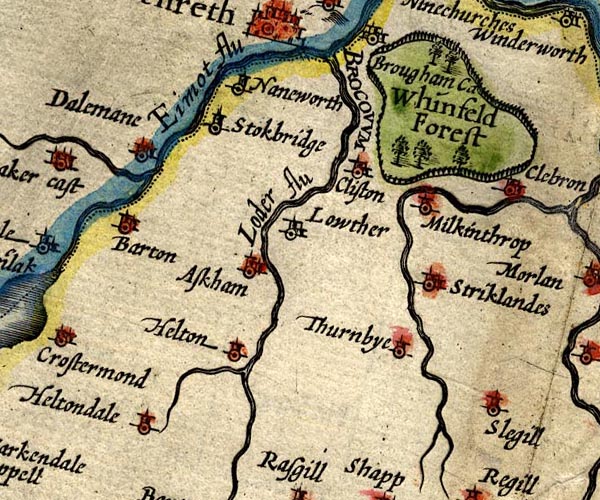
SP14NY52.jpg
"BROCOVUM"
no symbol
item:- Armitt Library : 2008.14.5
Image © see bottom of page
placename:- Bravoniacum
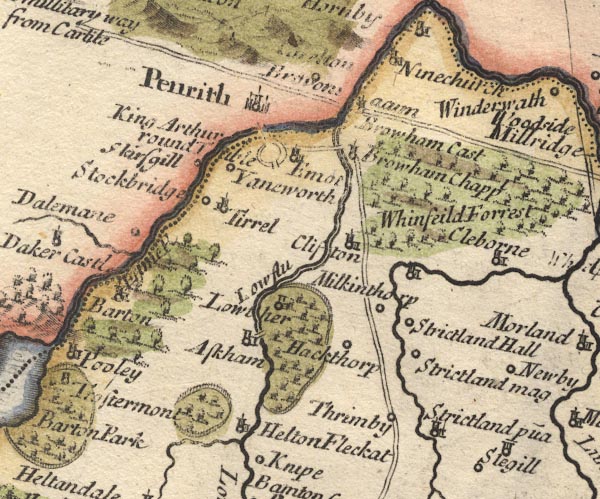
MD10NY52.jpg
"Bravon[i]acum"
item:- JandMN : 24
Image © see bottom of page
placename:- Overborough
placename:- Galava
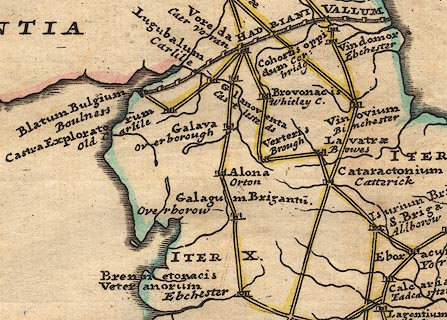 click to enlarge
click to enlargeStu1Cm.jpg
"Galava / Overborough"
item:- Hampshire Museums : FA2001.171
Image © see bottom of page
placename:- Brovoniacum
"The Roman highway, ... passing the Eden a little north from Perith, at an antient Roman station call'd Brovoniacum,"
placename:- Brovoniacum
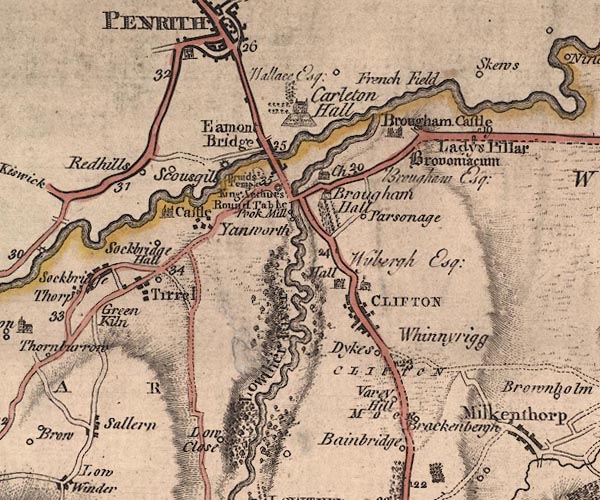
J5NY52NW.jpg
"Brovoniacum"
antiquity
item:- National Library of Scotland : EME.s.47
Image © National Library of Scotland
placename:- Brovocum
placename:- Broconiacum
 goto source
goto sourcePennant's Tour 1773, page 155 "[Brougham Castle] ... On its site, or perhaps near to it, had been the Roman station Brovocum, or Broconiacum. ..."
placename:- Brovoniacum
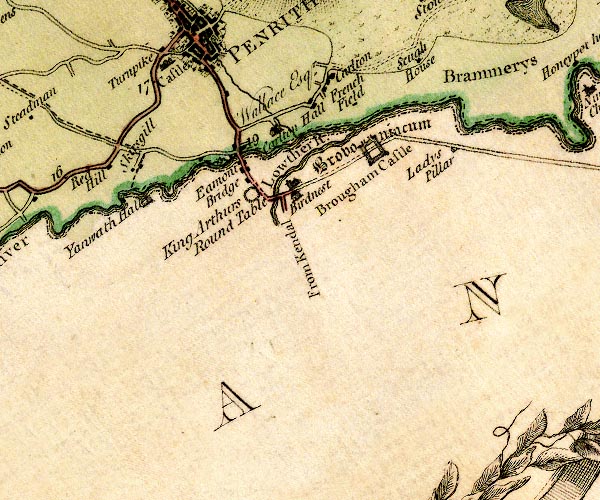
D4NY52NW.jpg
"Brovoniacum"
square within a square; roman fort, drawn boldly
item:- Carlisle Library : Map 2
Image © Carlisle Library
placename:- Brovacum
 click to enlarge
click to enlargePEN1Cm.jpg
"BROVACUM / Brougham"
circle; buildings, village, etc
item:- private collection : 66
Image © see bottom of page
placename:- Brocavum
item:- roman altar; altar, roman; roman inscription; inscription, roman
 goto source
goto sourcePage 160:- "..."
"It is agreed the BROUGHAM is the BROCAVUM of Antoninus' 5th Iter, not Brovoniacum, for there is no such name, but not the BRABONIACUM of the Notitia, which Gruter confounds with Brocavicum its Borcovicum. Antoninus's BROVONACAE, which Gale places at Kendal, and makes the same with Brocavum, is by Ward removed to Kirby Thor, or Whelp castle. Stukeley makes it Galava. Brougham castle stands within the station, and there is a fragment of an altar inscribed, PRO SE ET SVIS. L. L. M. remarkable only for the form of the stops. He says the Roman city lies on the east side of the Louther just by the castle, and is very easily traced. He saw many fragments of altars and inscriptions at the hall; and in the wall by the Roman road beyond the castle and near the countess of Pembroke's pillar a pretty busto part of a funeral monument, and further on another bas relievo much defaced. He imagined the high ground by this pillar, where most of the inscriptions were found, was the site of the city, rather perhaps of the pomaerium, or cemetery."
"Horsley gives Mr. Camden's inscription here thus:"
".IMP.
.C. VAL
CONST
ANTINO
PIENT
AVG:"
"and refers it to Constantine the Great, but of a later date than that in his honor found in the wall. He doubts if it be the same which Mr. Camden saw. It is now at Appleby. Under it had been another inserted in the wall, whence the inscriptions at Appleby were taken, though now they are lying loose on the ground. The inscription on this other stone is modern, and perhaps by Mr. Bainbrigg:"
"H. L. INVENT. E
BROVONACI."
"i.e. Hic lapsis inventus est Brovonaci."
"To this same station must be referred another inscription whose original Mr. Horsley would gladly have recovered, but was told two or three inscribed stones had lately been destroyed by masons at Appleby, and this might be one. Burton and Gale give it"
"DEABVS MATRIBVS
TRAMAI. VEX. GERMA.
P. V. R. D. PRO SALVTE
RFVS. L. M."
"which is to be read:"
"Deabus Matribus
tramarinis vexillato Germa-"
 goto source
goto sourcePage 161:- "norum quo salute
republicae volum solvit libens merito."
"norum quo salute
republicae volum solvit libens merito."
"..."
placename:- Brovoniacum
placename:- Brocovum
placename:- Broconiacum
item:- Antonine Itineraries; Notitia Dignitatum
 goto source
goto sourcePage 148:- "... BROVONIACUM, 20 Italian and 17 English miles from VERTERAE, as placed by Antoninus, who called it likewise Brocovum, as does the Notitia Broconiacum, adding that the Numerus Defensorum was stationed here. Though time has destroyed its buildings and glory, the name remains almost unaltered. For we still call it Brougham."
placename:- Brovoniacum
 goto source
goto sourcePage 134:- "..."
"BROUGHAM CASTLE,"
"On the site of the Roman Brovoniacum, at the confluence of the Eamont and Lowther, where many Roman remains have been found. ..."
item:- inscription, roman; roman inscription
 goto source
goto sourceGentleman's Magazine 1848 part 1 p.373 "... Dr. Markham, in the MS. before quoted, A.D. 1680, thus writes:- "That Browham was a Roman station is evident from the many Roman altars which have been frequently dug up here. In the year 1602 one was discovered near the confluence of the rivers Lowther and Eamont, with these letters inscribed,-"
"IMP
C. VAL
CONSTAN
TINO
PIENT
AUG"
"and of late years several of the like kind have been found in the fields, but so shattered and defaced by the rashness and negligence of the workmen and labourers, that the characters are not legible." These are now, as before stated, in the great court near the entrance gate tower [Brougham Hall], in a quiet snug corner, not exposed to any danger. Gale, in his edition of the Itinerary of Antoninus, ed. 1719, p.97,- the latter part of the fifth journey from London to Carlisle,- gives "Brovaco," Brougham, the intermediate station between Brough and Carlisle. Camden and Stukeley also mention the station. In Caxton's Chronicle, "The Description of Englande," &c. is the following passage:- "Other men wolde suppose yt Alcluid was that cite that now is called Burgham, in the north cou~tre of Westmorlonde, fast by Comberland, and standeth by the river Eden. The cite is there wondrously seen.""
placename:- Brovacum
 goto source
goto sourcePage 171:- "... Brougham, Burg-ham (meaning Castle-town) was the Brovacum of the Romans, where, as we learn from Nicolson and Burn, they had a company of Defensores, and left many tokens of their presence in antiquities which have come to light from time to time. ..."
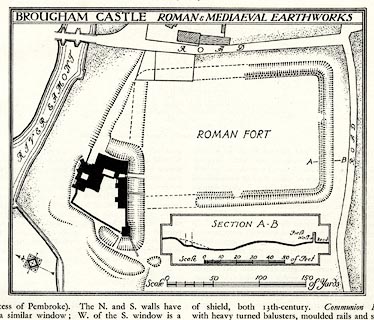 click to enlarge
click to enlargeHMW039.jpg
On p.55 of the Inventory of the Historical Monuments in Westmorland.
printed, top "BROUGHAM CASTLE ROMAN AND MEDIAEVAL EARTHWORKS"
RCHME no. Wmd, Brougham 1
item:- Armitt Library : A745.39
Image © see bottom of page
placename:- Brocavum
placename:- Brocavo
placename:- Brocavum
placename:- Brougham
 click to enlarge
click to enlargeHOR1Cm.jpg
"Brocavum / Brougham"
item:- JandMN : 429
Image © see bottom of page

BTF54.jpg Roman inscription (at Brougham Castle).
(taken 18.7.2010)
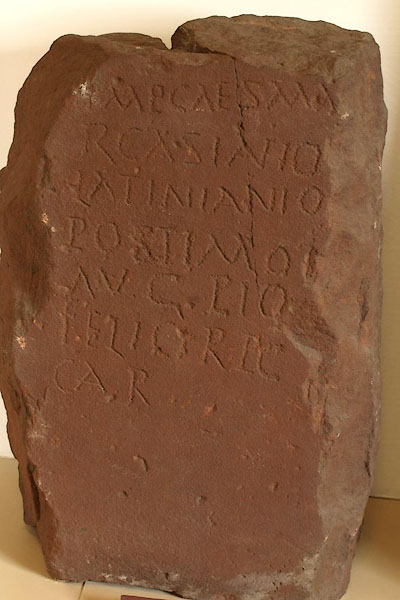
BTF55.jpg Roman inscription (at Brougham Castle).
(taken 18.7.2010)
